Listos California: Bringing Equity to Disaster Preparedness
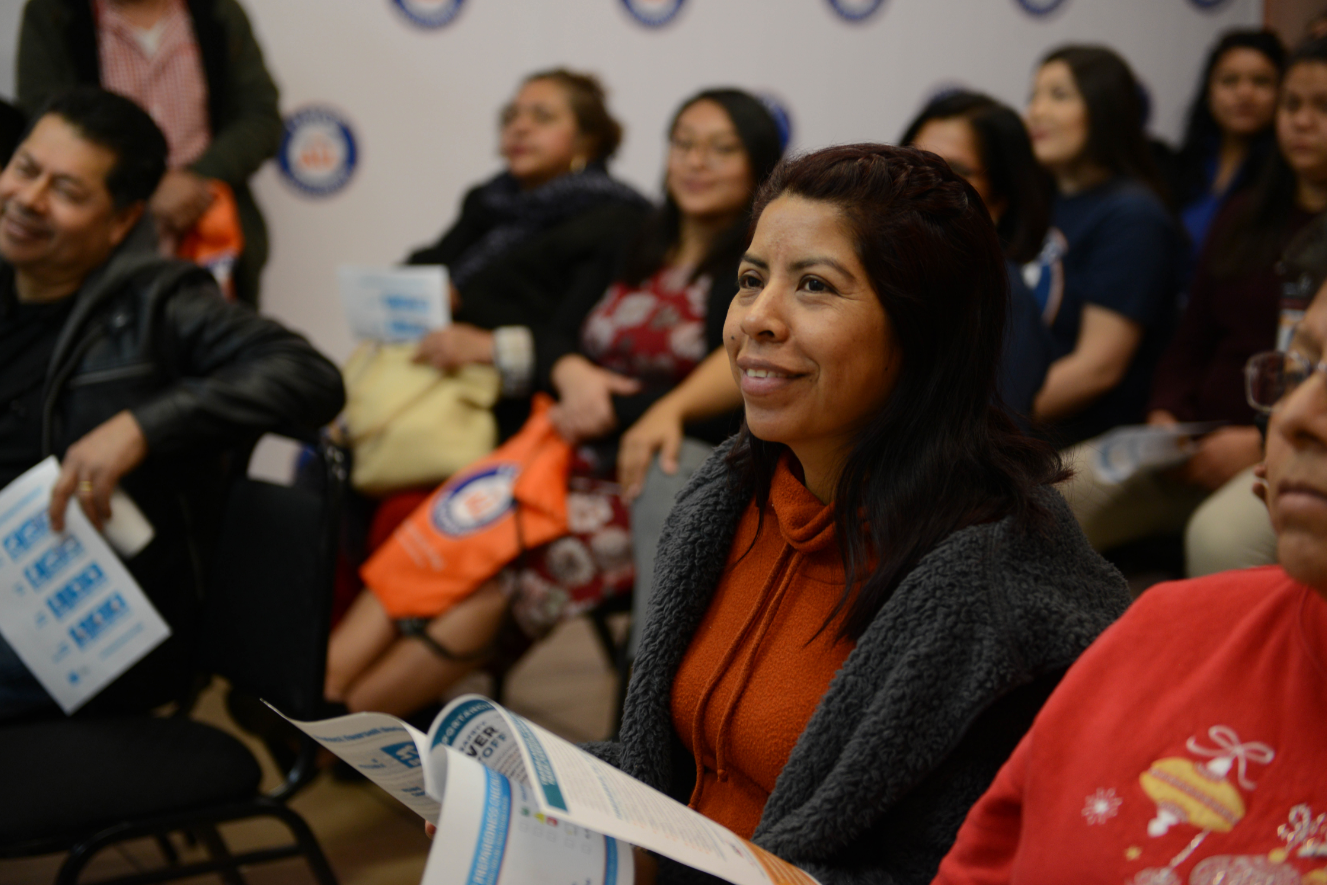
Year after year, California is reminded of the devastation brought by wildfires and other natural disasters. That devastation has disproportionately impacted our state’s diverse and vulnerable populations – our older adults, people with disabilities, residents with language barriers, families in poverty, and others who are isolated, whether due to cultural, geographic, or other circumstances.
Valley Vision was proud to help combat this reality while serving as the backbone organization for the Listos California emergency preparedness campaign from 2019 to 2021. It was our first statewide project with implementation taking place almost entirely outside of the greater Sacramento region, where most of Valley Vision’s work typically takes place.
Listos California is a first-of-its-kind effort to bring equity to disaster preparedness, launched by the Governor and State Legislature in 2019 and anchored at the Governor’s Office of Emergency Services (Cal OES). The campaign was designed with the sole intent of providing diverse and often overlooked populations with knowledge and tools to be better prepared if ever faced with an emergency.
To ensure campaign messaging would effectively reach and resonate with the primary audiences, Listos California took a studied approach and developed new tools in formats and styles to appeal to the diverse audience groups. More than 80 unique assets were developed and presented in more than 20 languages. Perhaps even more significant than the tools developed, however, was the approach that Listos California took to reaching the targeted audiences. The state, through Cal OES and California Volunteers, awarded grants to more than 80 community-based organizations and service organizations around the state. The grantees were selected because they understood their local communities, knew which populations needed to be reached and which trusted voices would capture the attention of targeted populations most. They also knew where to go and which mediums to use to reach the populations. It was this on-the-ground knowledge and ability to customize at the local level that fueled the success of the campaign.

In our role, Valley Vision provided guidance and technical assistance to the grantees to help amplify their respective and collective impact. We also oversaw the work of dozens of creative, strategic, and production consultants and vendors that developed curricula, content, and assets used to engage targeted audiences. This organizational backbone role also provided us with the ultimate vantage point to observe what can be accomplished when you have the right mix of partners, all of whom are passionately committed to a cause.
The state’s initial goal for Listos California was to engage one million diverse and vulnerable Californians with emergency preparedness information. The campaign blew this goal out of the water by ultimately engaging nearly four million residents with actionable emergency preparedness education. These individuals and families are now more prepared and resilient if they are ever confronted by a disaster. The Listos California Impact Report and corresponding Innovations for Equity in Disaster Resilience report share the experience and results of the campaign, and also provide a blueprint and recommendations for how similar equity-focused efforts might be constructed. All those interested in equity – whether specific to disaster preparedness or in other areas – should scan the report and take what you can to inform future work. The strategies employed and lessons learned serve as fodder for those interested in actively engaging populations that have too frequently been overlooked.
To keep up with Valley Vision’s work to advance livability in the Sacramento region, subscribe to our Vantage Point email newsletter!
Alan Lange is Valley Vision’s Director of Production, and project lead for Valley Vision’s contributions to the Listos California campaign.
Air Quality Data Now Monitored in Sacramento Frontline Neighborhoods
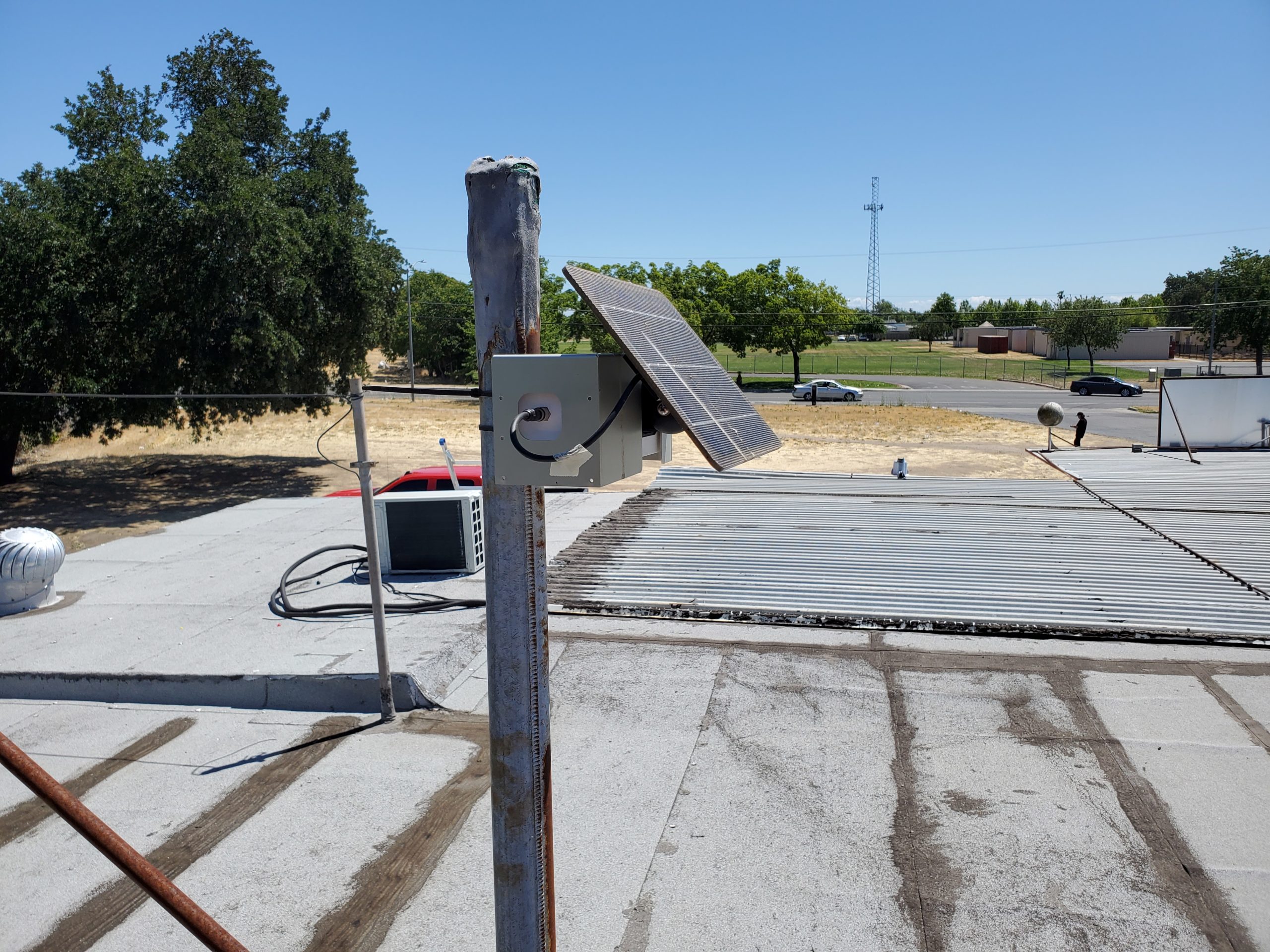
Over 20 air quality monitors being installed on rooftops by community groups in North Sacramento and Oak Park to collect needed data.
SACRAMENTO, CA – JUNE 29, 2021: Efforts to advance environmental justice for frontline Sacramento neighborhoods reached an important milestone with the launch today of a new public data portal that offers live readings from more than 20 rooftop solar-powered air quality monitors. The equipment is part of a larger grant from the California Air Resources Board (CARB), awarded in 2020 to the Sacramento Neighborhoods Activating on Air Quality coalition (SNAAQ).
“Sacramento suffers from serious air quality and public health challenges,” said Patrick Guild, Chief Operating Officer of Breathe California Sacramento Region. “But there are some neighborhoods like North Sacramento and Oak Park that have long been air monitoring ‘deserts’ and we have very little understanding of how poor the air quality may be for residents living in those communities.”
CARB’s Community Air Protection program is meant to help residents of high pollution-burden communities better understand air quality conditions at a block-by-block level and to address environmental injustices. The rooftop monitors measure particulate matter (PM 2.5) and NOx, two types of pollution that cause adverse health impacts that disproportionately fall on communities of color who generally live where pollution concentrations are highest. The new air monitoring equipment is now collecting and transferring data to a public portal, giving residents and advocates a much better understanding of the conditions in these neighborhoods. The data will be evaluated and ultimately will help residents determine future actions and needed investments.
“I think about the generations before and after me, from a researcher’s point of view, and I wonder how many have asthma, allergies, and other health conditions based on factors from their zip codes,” said Nykchasia S. Scott, MSSW, a North Sacramento resident and part of the all-resident committee who determined air monitor locations.
The SNAAQ coalition is comprised of area nonprofits Valley Vision, WALKSacramento, Breathe California Sacramento Region, and Green Tech Education, in partnership with neighborhood residents and clean air advocates who are working together to identify priorities for action that could likely include securing additional funding for clean air projects in our local communities and advocating for new statewide policies and regulations that reduce air pollution.
“This project is fundamentally about ensuring that all residents in our communities are afforded the basic rights to live, work, go to school, play, and pray in a safe, healthy, and clean environment,” said Kiara Reed, Executive Director of WALKSacramento. “We are providing the tools and information that these frontline communities need to adequately and proactively address air quality concerns in their own neighborhoods.”
###
About Valley Vision: For more than 25 years Valley Vision has used research to help governments, businesses, foundations and community groups better understand the issues facing our region. We believe that knowing and understanding the facts is the best way to establish a common working foundation for collaborative problem-solving. That’s why Valley Vision conducts, produces and interprets research including scientific public opinion polls, focus groups, community needs assessments, best practice studies and other research tools to bring to light the information local leaders need to improve our communities.
About WALKSacramento: WALKSacramento is a nonprofit planning and advocacy organization that improves quality of life and health equity in the Sacramento Region through community-centered policy and systems change in land use, transportation, and community development. For the last 20 years, WALKSacramento has worked closely with residents and community partners in institutionally underserved communities to empower community voices and co-create healthier, more equitable, and sustainable neighborhoods for all.
About Breathe California Sacramento Region: Breathe California Sacramento Region is an air quality and tobacco cessation-focused nonprofit that has served Sacramento for more than 100 years. Recognizing the significant impact that lung health has on the overall health of all communities in the Capital Region, Breathe has prioritized two significant areas of lung health in its mission: improving environmental air quality and eliminating commercial tobacco use through meaningful community engagement, enriching educational efforts, strategic partnerships, innovative programming, and effective advocacy.
About Green Tech Education: Established in 2008, Green Tech is committed to providing career technical education, job creation, job training, and entrepreneurial opportunities in the green economic sector. The program serves as a critical economic development resource for youth from underprivileged backgrounds. Green Tech is charged with simultaneously developing clean energy workforce skills and reversing the negative human impact on our environment.
Hybrid Work: The Disruption of 2021

With June 15th passing this week, marking California’s first opening since the pandemic hit, returning to the office and creating hybrid work environments is front of mind for many employers and employees. Microsoft Worklab published a recent report on hybrid work as the next big disruption – what are the big trends, how are they playing out in our region, and where do we go from here?
1. Flexible work is here to stay
Many workers got to experience remote work for the first time and don’t want to leave the positives of the experience behind. Nationwide, 70% want to retain a hybrid model although many are also clamoring for in-person time with their teams. In our region, the COVID-19 Resilience Poll tells us that 63% of workers worked full-time in office before the pandemic but 69% want a hybrid model now to avoid commutes and maintain more flexible hours.
2. Leaders need increased connection to workers
A recent study shows that business leaders are faring better than their employees throughout the pandemic with 61% saying that they are thriving while only 38% of those without decision-making authority say the same. Further, disparities in pandemic impacts are contributing to a divide – younger workers, workers of color, and women have struggled through the pandemic more intensely than others and are less likely to be in leadership roles at work.
3. High productivity is masking an exhausted workforce
Anecdotally, companies are reporting high productivity this year with commute, travel time and distractions of the office eliminated. Microsoft data shows that chats, emails, meetings, and time spent in documents have significantly increased between February 2020 and February 2021. It also shows that 54% of workers feel overworked and 39% feel exhausted. Digital overload and increased isolation are seriously taxing workers.
4. Gen Z is at risk and will need to be re-energized
Gen-Z, or those between 18-25 years old, are feeling these effects the strongest. 60% of Gen Z are merely surviving or flat-out struggling right now. This age demographic reports struggling to get new ideas on the table, get a word in during meetings, and feel excited or engaged about work. Because they are younger, often single, early in career, and less financially stable – isolation, network connections, and meaningful engagement has been much harder during the pandemic. The COVID-19 Poll found that in our region these factors and others contributed to higher rates of stress, anxiety, and depression for our younger respondents.
5. Shrinking networks are endangering innovation
The pandemic shrunk our worlds – both personally and professionally. Research shows that interactions with our close networks increased while our interactions with our more distant networks decreased. This reduces the inflow of new ideas, stifling innovation.
6. Authenticity will spur productivity and wellbeing
2020 was the year that home life was made visible at work – children, pets, and personal spaces came with many of us to our virtual meetings and as a result we had the opportunity to see each other as full humans in ways that never came through in routine office life. Additionally, our shared vulnerability of going through a tough time together bonded co-workers in new ways.
7. Talent is everywhere in a hybrid work world
The pandemic accelerated the notion that we can work from anywhere – and that is exactly what many workers want to do. A study from LinkedIn reports that remote job postings increased five-fold and 46% of workers say they want to move this year, anticipating continued remote work opportunities. Remote work can increase access to job opportunities for underrepresented groups – the same study found that women, Gen-Z, those without a graduate degree are more likely to apply for remote work and women, Black, and Latino workers are more likely than white men to prefer remote work. People are at inflection points in their careers with 41% noting that they’d like to leave their job within the year. In Sacramento County, 40% of jobs are remote eligible by function, as reported by the Bay Area Council Economic Institute. Additionally, the trend is that people in high cost areas are moving to lower cost areas – translating to an influx of Bay area residents to our region, a spike in real estate prices and growth in our professional workforce.
The trends are clear – we are in the midst of major disruption and transition to different ways of doing work. There are some clear recommendations for both employers and the region at large:
Empower workers to be able to work in office or remote environments: a mix of both will result in flexibility, productivity, and increased connection and collaboration. Just as employers pivoted to remote, now is the time to pivot again to safely open offices and create a new type of environment that embraces hybrid work where possible. Solutions should address technology tools, office design, home accomodation, and policy practices that maximize hybrid options.
Combat digital exhaustion starting from the top: Leaders need to understand the challenges of workers and actively promote a culture that encourages strong work/life boundaries and downtime. Organizations and companies need to strengthen diversity, equity, and inclusion practices and policies to address the intersectional burdens that people of color and other underrepresented groups face at work.
Rebuild our collaborative fabric: Isolation and smaller networks have marked 2020 and 2021 so far. Expanding networks, building collaborative opportunities and environments, and reacquainting with more distant networks (slowly for introverts!) will be a key activity of 2021.
Enhance employee experience to attract talent: While workers are reconsidering career, location, and the opportunity landscape, employers must cultivate a diverse, inclusive, and flexible culture to attract top talent.
By maximizing the positives of the remote work experiences that we have experienced while mitigating the isolation and digital overload of the past year, 2021 is an opportunity to build stronger, more resilient organizations and businesses to support a trhiving, healthy, and innovative workforce.
To keep up with Valley Vision’s work to advance livability in the Sacramento region, subscribe to our Vantage Point email newsletter!
Evan Schmidt is Valley Vision’s Chief Executive Officer.
Skills for a Ready Future Workforce

Valley Vision has been examining Future of Work trends for many years. Our latest research was made possible through funding from the City of Sacramento CARES COVID Relief and in partnership with Burning Glass Technologies. This analysis sought to answer the question, where should resources be targeted to provide the most effective skills acquisition and training, especially to disproportionately impacted community members, to enhance and accelerate recovery from the pandemic.
Building on previous work, Automation Risk for Jobs in the Capital Region (March 2020) report looking at the potential impacts of automation in our nine county region, recovery from the pandemic and future workforce development strategies need to be responsive to multiple factors including:
• Meeting current and projected job needs
• Reducing future risk of automation/obsolescence
• Improving job quality (higher wages, benefits and career advancement opportunities)
• Improving equity for communities of color, women and underserved groups
The following white paper highlights the result of these efforts:
To keep up with Valley Vision’s work to advance a future-ready workforce in the Sacramento region, subscribe to our 21st Century Workforce email newsletter!”
Renee John is a Valley Vision Project Leader managing initiatives within the 21st Century Workforce impact area.
New Study of Region’s Food System – and Prevailing Gaps – to Launch
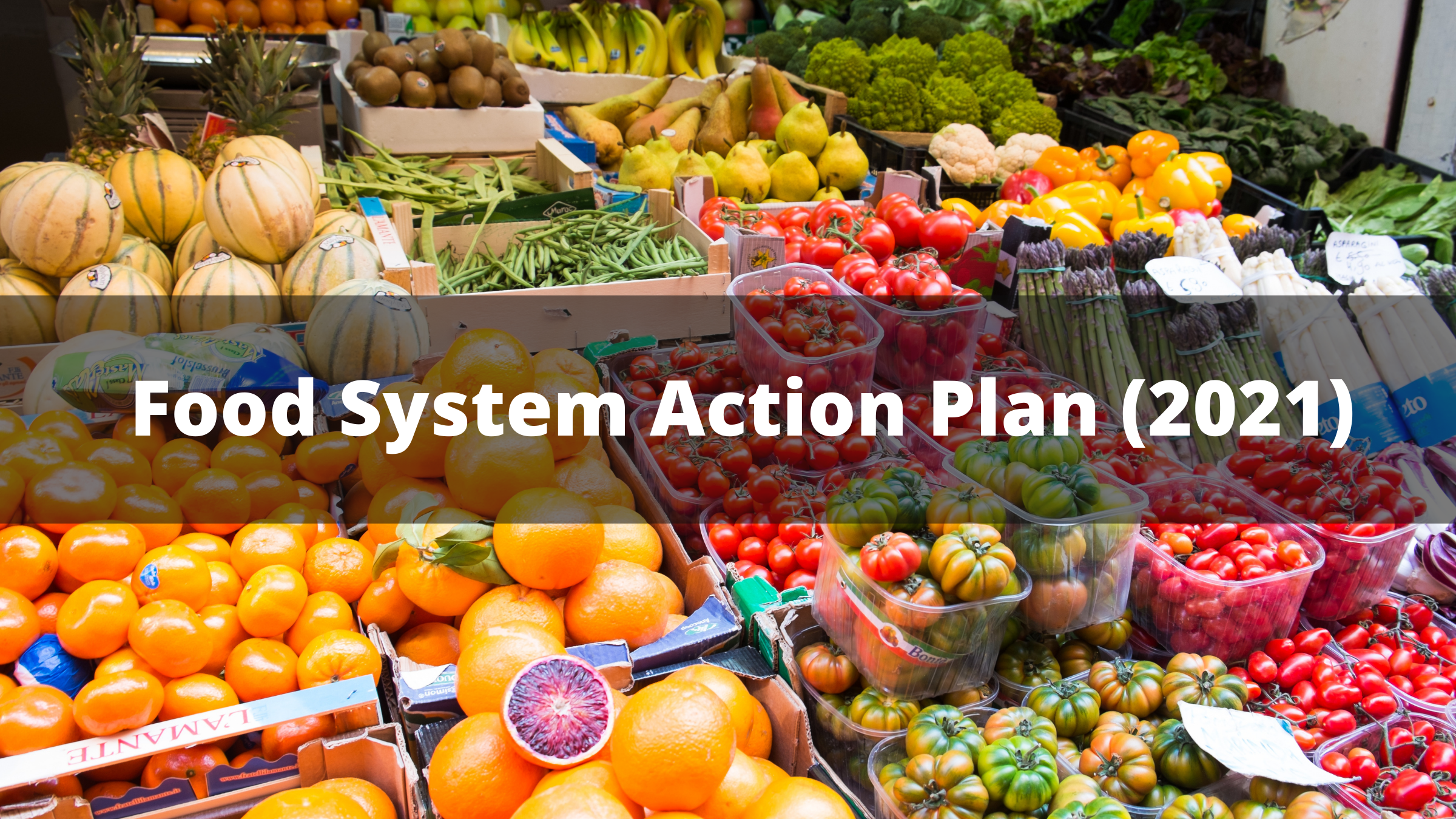
SACRAMENTO, CA – MAY 19, 2021: The Sacramento Region Community Foundation (Foundation) and Valley Vision announced today a new research study being jointly launched on the region’s food economy and prevailing gaps in the greater Sacramento region’s food system. The research will inform recommendations for investment strategies to strengthen the region’s food system capacity and resiliency.
“The region’s food system is dynamic and complex,” said Linda Cutler, CEO of the Sacramento Region Community Foundation. “While the overall food economy has advanced in recent years through dedicated efforts like new job creation, workforce programs, institutional procurement, and food literacy, disparities persist around food access, security, and system capabilities that have been further exacerbated by the COVID-19 pandemic.”
The study will build upon earlier work highlighted in the Sacramento Region Food System Action Plan (FSAP), a seminal study conducted by the Foundation in partnership with Valley Vision in 2015. The FSAP laid the building blocks for a regional roadmap and identified an actionable role for the Foundation that it has worked to implement since.
Valley Vision conducts public opinion polls in partnership with the Institute for Social Research at Sacramento State and will field this new poll in June to collect data on residents’ experiences, perceptions and needs related to accessing food. The Food System poll, in addition to other engagement and data inputs, will provide the Foundation with invaluable information that will be used to update the 2015 FSAP.
“The ultimate goal of this research is to ensure the viability of the food and ag economy at all scales,” said Valley Vision CEO Evan Schmidt. “This includes increasing the amount of locally grown food distributed within the regional food system, increasing access to fresh, affordable produce, especially in underserved communities, and increasing consumption of healthy foods through access to nutrition education.”
The research findings will support meaningful collaborations among food system partners and improve alignment of system activities and investments. Findings will also help identify compelling short- and longer- term priorities and establish a baseline for future progress.
“This is incredibly important work for our region,” said Kate Stille, Sacramento Region Community Foundation Board Chair and Chief Impact Officer for Nugget Markets, Inc. “We can point to real and tangible results born out of the 2015 FSAP, which has dramatically improved food security in underserved communities by strengthening the emergency food distribution network.” The 2015 FSAP inspired a partnership between the Foundation and Sacramento Food Bank & Family Services to form the Neighborhood Food Access Networks, which today serve hundreds of thousands of people by networking together more than 200 emergency food distributors across Sacramento neighborhoods.
The work to strengthen the food system is all-the-more critical given the COVID-19 pandemic, which greatly impacted health and economic disparities in the local community. High unemployment has increased the level of need for food. Local food banks, schools, restaurants, and many others have created new distribution mechanisms to respond to the crisis. The FSAP is a blueprint for action that will help shape these types of strategic initiatives, as well as to inform local leaders and the community on how to engage in meaningful solutions and catalyze investments in our vital food system.
“A systems approach centered on equity is needed,” said Schmidt. “Understanding food access and security issues is paramount to ensuring a health-promoting and accessible food system that can serve the needs of those who live in the region as well as those who benefit from our rich agricultural valley nationally and globally.”
The public opinion poll will go into the field in June and findings are expected to be published in September.
###
About the Sacramento Region Food System Action Plan (FSAP): FSAP was a seminal study conducted by the Foundation in partnership with Valley Vision in 2015 and provided a common framework along with integrated goals, strategic priorities, and recommended actions to strengthen the food system for the region. Intended to serve as a roadmap for food system development, function, and investment, the FSAP identified several disconnects in the food system, including the gaps between great food abundance and a vibrant economic sector, high levels of food insecurity, poor food-related health outcomes, and missed opportunities for local food sourcing and markets.
About the Sacramento Region Community Foundation: For over 35 years, the Sacramento Region Community Foundation has been the capital area’s trusted steward of charitable assets and champion for impactful philanthropy. The Foundation’s mission is to transform the capital area through focused leadership and advocacy that inspire partnerships and expand giving.
About Valley Vision: For more than 25 years Valley Vision has used research to help governments, businesses, foundations and community groups better understand the issues facing our region. We believe that knowing and understanding the facts is the best way to establish a common working foundation for collaborative problem-solving. That’s why Valley Vision conducts, produces and interprets research including scientific public opinion polls, focus groups, community needs assessments, best practice studies and other research tools to bring to light the information local leaders need to improve our communities.
Spring Advisories: Preparing our Regional Workforce for Success
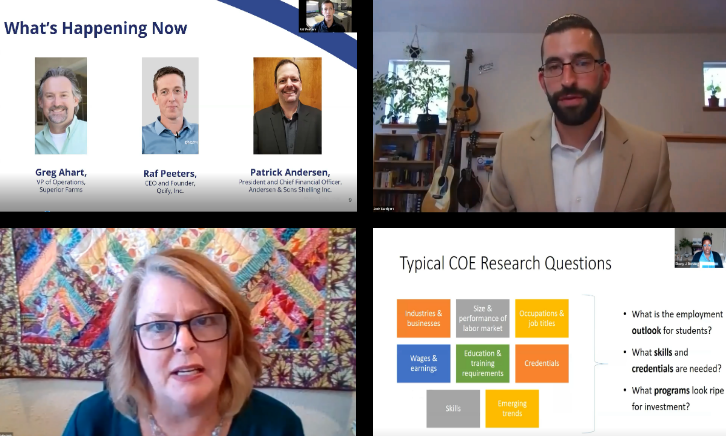
April 2021 was a month filled with dynamic industry discussions for Valley Vision, as it hosted three Regional Industry Advisories funded by Los Rios Community College District Strong Workforce Program and in partnerships with Sierra College, Yuba Community College District, and the Capital Region workforce boards. The Advisories’ objectives included building strong relationships between employers, educators, and workforce partners that provided timely information on skills gaps and opportunities for more ongoing engagement. April’s advisories served to foster workforce pipelines into the Sacramento Region’s diverse sectors, some of which have been especially harmed by the ongoing COVID-19 pandemic. However, as emphasized throughout the Advisories, the region’s workforce partners can play a strong role in meeting industry demand for a skilled workforce that helps industries pivot and thrive.
The month’s series of virtual Advisories began with Retail, Hospitality, and Tourism (RHT), an industry especially hard hit by the COVID-19 pandemic, but in recovery. Keynote Speaker Mike Testa of Visit Sacramento shared an optimistic re-opening of Sacramento’s RHT industry and its benefits for the region, saying “This isn’t just about the City of Sacramento – it’s about everybody else“. An Industry Insights Panel featuring employers followed, emphasizing how businesses pivoted with COVID-19 and their demand for a diverse RHT workforce that possesses critical thinking, emotional intelligence, and communication skills. Afterwards, Dr. Robert Eyler offered an engaging presentation on economic and policy conditions behind the RHT industry. For a more detailed look at the Advisory, take a look at our separate blog on the event here!
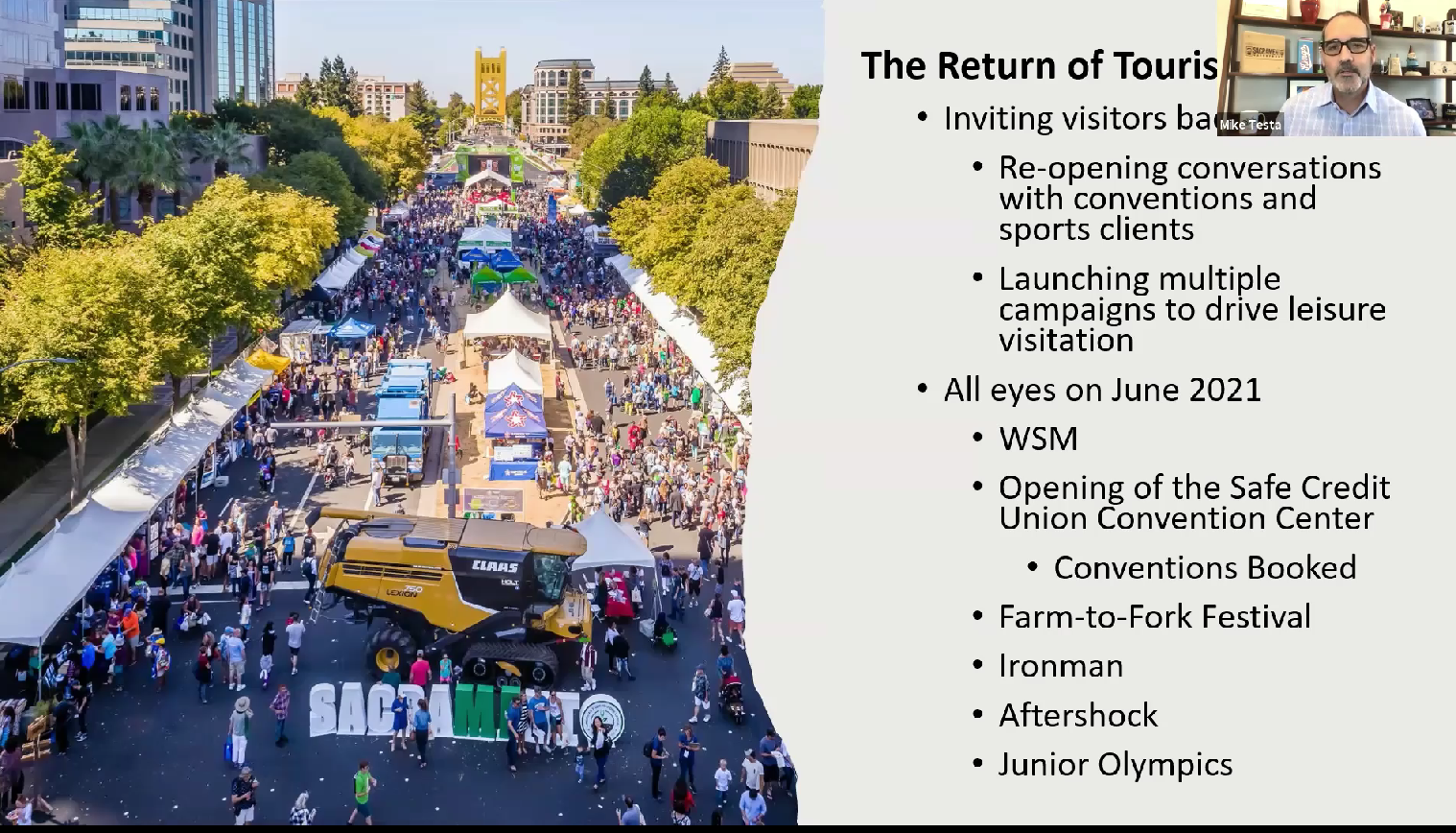
Next was a Regional Industry Advisory on Gerontology, Geriatrics and Business Services in the Field of Aging, which began with a presentation on shifting demographics and occupational data by North/Far North Center of Excellence Research Manager, Ebony Benzing. This data further informed industry insights provided by keynote speaker Leading Age California President and CEO, Jeannee Parker Martin, and the employer panel on arising issues in the field. Towards the end of the event, American River College’s Gerontology Department Chair and Career Education Program Coordinator, Laurinda Reynolds, presented on ageism and interventions that could promote careers in the field.
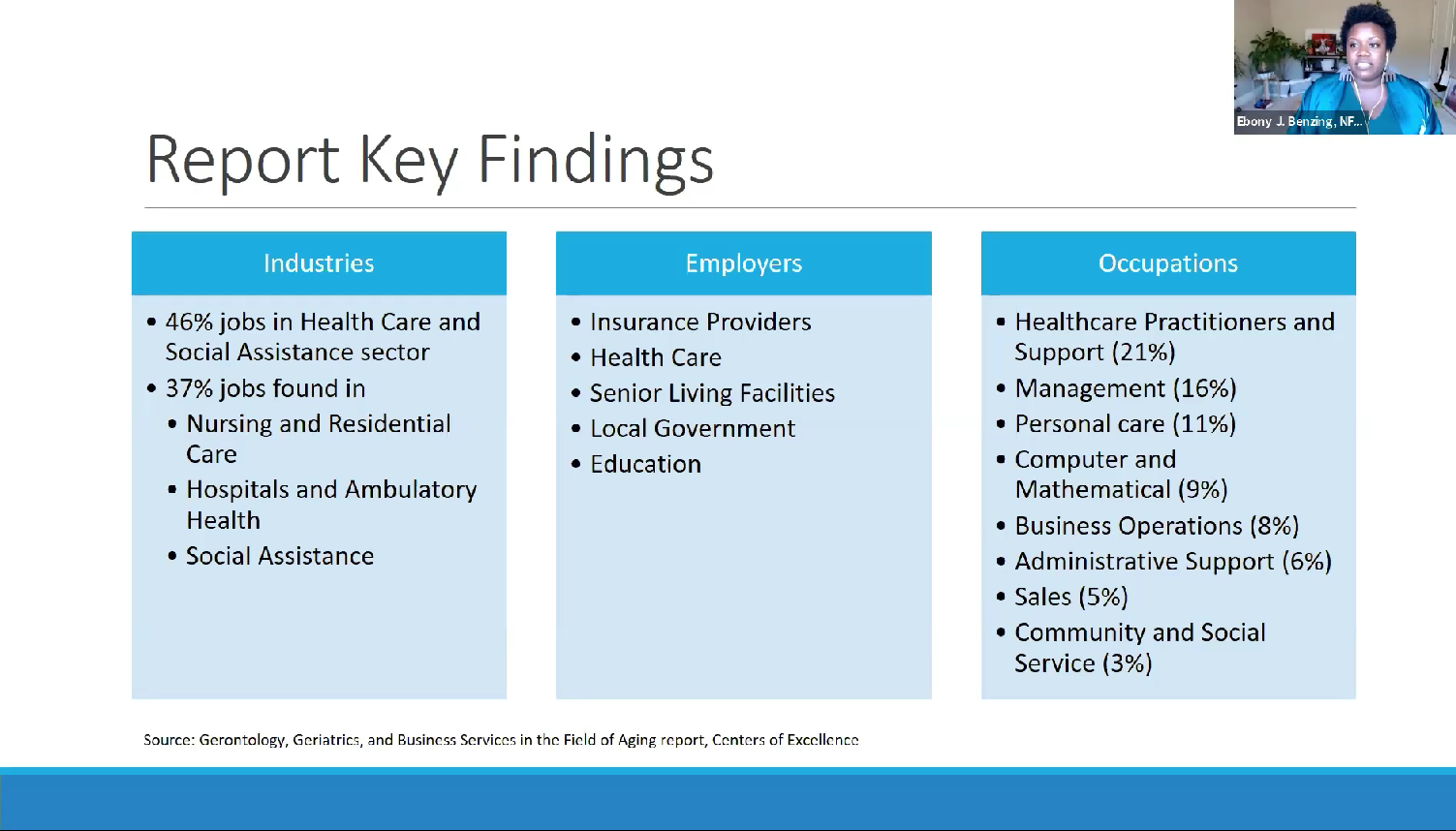
The month’s Advisories finished off with a cross-sector look at Automation & AI in Agriculture and Manufacturing. The event uniquely featured two industry panels, one focusing on current employer needs and the second focusing on the future of automation in food processing. “There’s a common theme when you walk into a processing plant… how can we keep the plant running, with limited supply of people who are available? That is the biggest challenge,” described Raf Peeters, CEO and Founder of Qcify, Inc. and one of the Advisory’s employer panelists. Employers went on to describe the need for workers who can operate this automation and AI technology, which workforce partners can assist with through course development and trainings
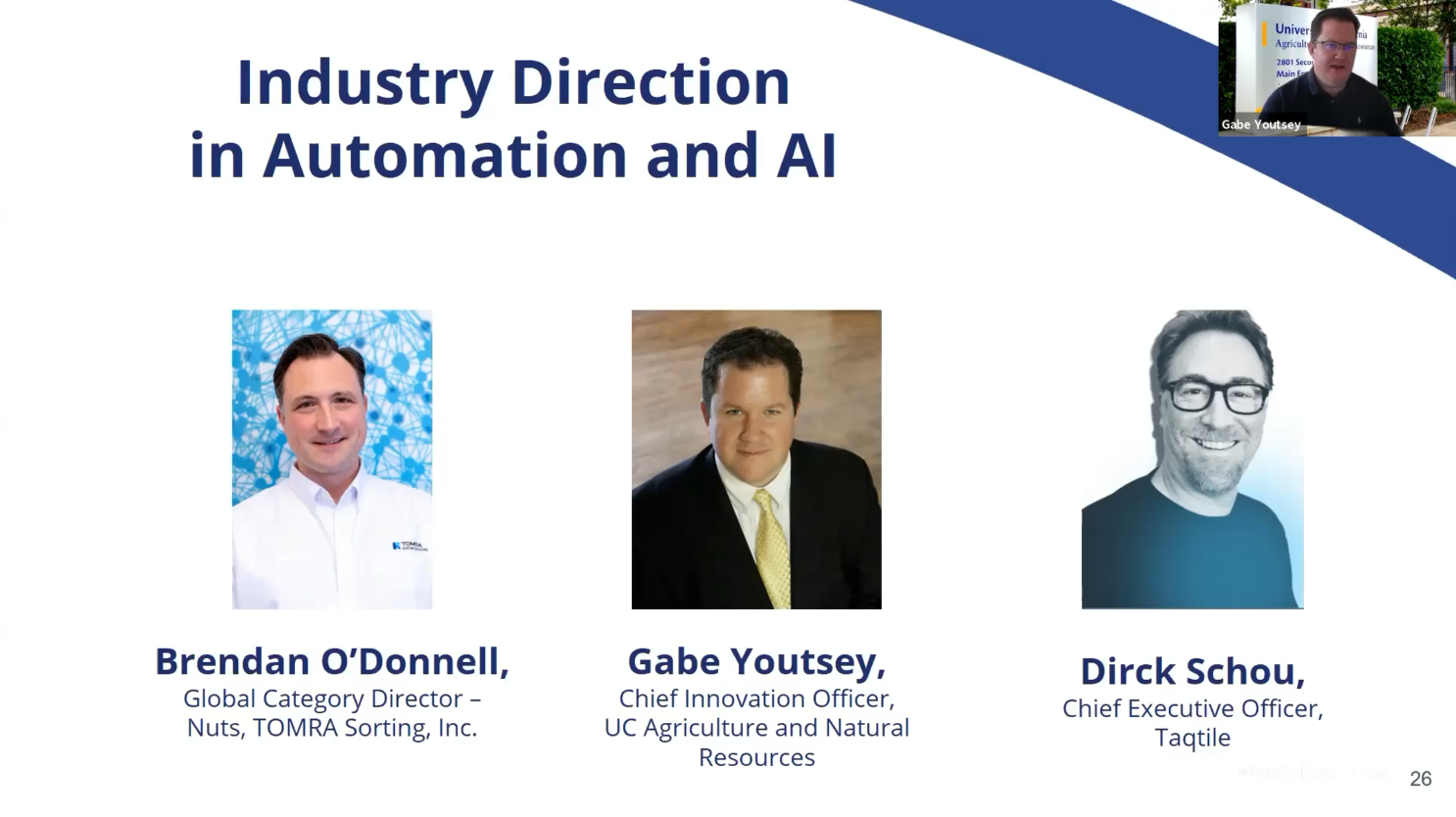
By the end of April, Valley Vision and its community college and workforce partners had successfully facilitated a wide range of opportunities for employer engagement to inform curriculum development. The ongoing pandemic’s toll on Sacramento Region industries has made it increasingly important for workforce pipelines to be responsive to employer and worker needs. These needs have been carefully documented by Valley Vision staff throughout its 2020-21 academic year advisories, which included data-driven presentations and employer discussions on the following sectors:
- Advanced Manufacturing
- Agriculture, Water, and Environment Technologies
- Business and Entrepreneurship
- Energy, Construction, and Utilities
- Health Services
- Information and Communication Technologies
- Retail, Hospitality, and Tourism
Additional information on advisories can be found via the links above. Valley Vision and the Sacramento Region’s workforce stakeholders greatly appreciate the attendees who have contributed their valuable insights into the curriculum development process.
To keep up with Valley Vision’s work to advance a future-ready workforce in the Sacramento region, subscribe to our 21st Century Workforce email newsletter!
Jesse Flores is a Valley Vision Project Associate supporting initiatives within the 21st Century Workforce and Clean Economy impact areas.
Retail, Hospitality and Tourism Headed Toward Recovery

While many different industries and sectors bore the brunt of the impacts of the past year’s pandemic, few were as impacted as Retail, Hospitality and Tourism (RHT). As we look forward to a post-pandemic world, what will the future of these industries look like in our region?
On April 16th, Valley Vision, in partnership with the Los Rios Community College District, and in collaboration with Sierra College, Yuba Community College District and the Capital Region workforce boards, held a Regional Advisory on Retail, Hospitality, and Tourism occupations and careers. Regional Advisories provide forums for industry and employer representatives to discuss their current and expected skill needs with educators and workforce system stakeholders. These advisories, funded by Strong Workforce Program, ensure community college and workforce training programs are responding to industry needs, preparing students and community members for the continuously evolving world of work.
The advisory began with Mike Testa, President and CEO of Visit Sacramento, providing an encouraging forecast. He discussed multiple events and campaigns scheduled to draw visitors back to our region including Farm-to-Fork Festival, Tower Bridge Dinner, Ironman Triathlon, Aftershock Music Festival, and Junior Olympics in 2022. The anticipated reopening of the Safe Credit Union Convention Center will also be a huge draw for visitors and conference attendees. Visit Sacramento looks beyond simply boosting the economy, and providing jobs as the city reopens according to Testa, “At Visit Sacramento, internally we say that tourism isn’t about the tourist – it’s about driving revenue for the residents that live here. The money that comes in improves the lives of our residents.”
Next up, Dr. Robert Eyler, President of Economic Forensics and Analytics, Inc., provided a look at the changing dynamics in these industries over the last year and projections for recovery. Examining from a macro lens, he described how the hospitality industry in California displayed the most dramatic job loss, at nearly 30% loss of employment since March of 2020. While a handful of sub-sectors within the Retail industry profited during the pandemic, including e-commerce, retailers selling building or gardening materials, and food or beverage retailers, the majority of the industry suffered job losses from 2.6% to 18.6%. Dr. Eyler remarked that while the past year for the RHT sector has been grim, Summer 2021 hints at the beginning of recovery for restaurants and retail with travel picking up in 2022 and 2023, and full recovery (pre-COVID levels) expected by 2024 or 2025.
Several regional employers participated in the panel discussion including: Tim Stallings – Sacramento Republic Football Club; Bahar Abullarade – Raley’s Supermarkets; Alycia Harshfield – California Restaurant Foundation; Bobbin Mulvaney – Mulvaney’s Building & Loan Restaurant; and Lynn Mohrfeld – California Hotel and Lodging Association. They shared the ways COVID-19 affected their businesses and delved into the types of skills and knowledge students and individuals interested in joining the RHT sector will need. The panelists unanimously agreed that emotional intelligence skills – often known as “soft skills” – were crucial indicating candidates who possess critical thinking skills, interpersonal skills, and the ability to effectively communicate are highly sought after. In the digital age of the pandemic, panelists explained that most of their workers quickly adapted to technological changes, but struggled when it came to effectively connecting with their clientele and fellow staff members. The employer panel also stressed the importance of team-building, working collaboratively, and the ability to work with diverse groups.
While the pandemic has brought with it a continuous wave of uncertainty, the promising projections from Mike Testa and Dr. Eyler, along with accounts of resiliency and adaptability from industry representatives, provided an encouraging picture of a sector headed toward recovery. Even within an increasingly technological age, this advisory has shown the way to be successful in RHT occupations and careers is to embody key parts of the industry itself – forming connections, working together, and serving your community.
To keep up with Valley Vision’s work to advance a future-ready workforce in the Sacramento region, subscribe to our 21st Century Workforce email newsletter!
Caitlin Blockus is a Valley Vision Project Associate supporting initiatives within the 21st Century Workforce impact area.
COVID-19 Imposed Inequitable Hardships on People of Color and Younger Adults, Latest Public Opinion Poll Reveals
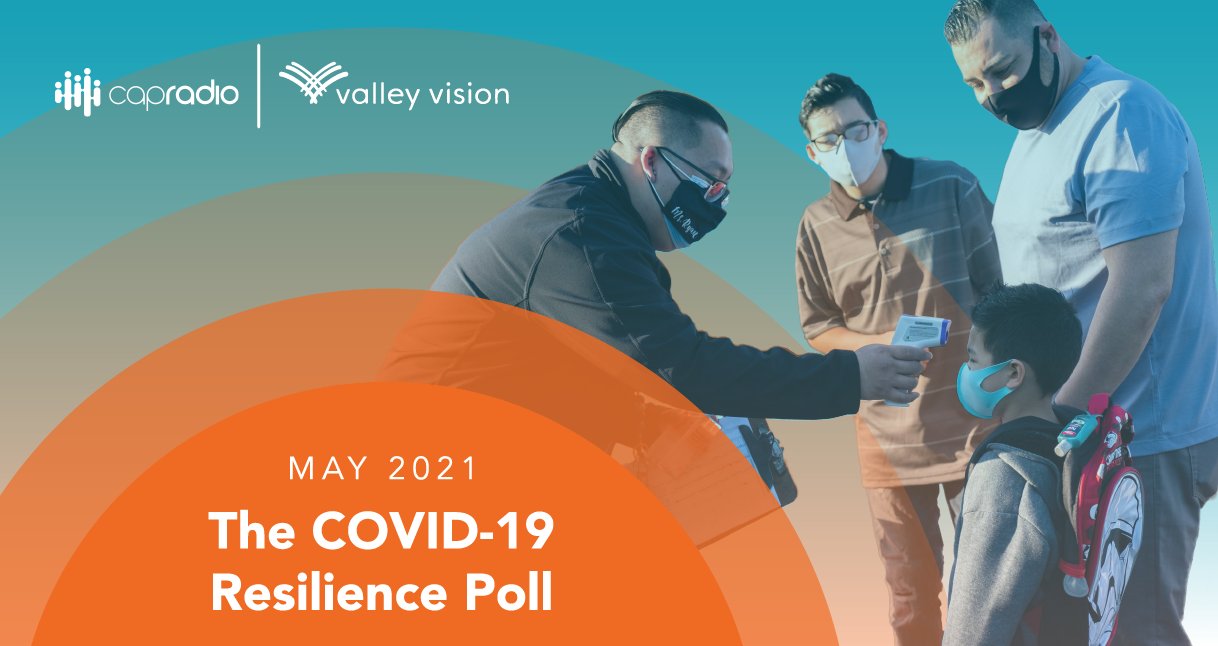
Sacramento, CA – May 10, 2021: Three public opinion polls fielded through a year of the COVID-19 pandemic from May 2020 to March 2021 revealed that the health crisis had a significant impact on the financial and emotional well-being for many. Communities of color, those earning less, and those who are younger, have been more severely impacted than others, experiencing greater income loss, more difficulty affording basic necessities, and deeper fears and concerns about financial security and mental health.
Valley Vision and CapRadio released today the third and final COVID-19 Resilience Poll, which was fielded by the Institute of Social Research (ISR) at Sacramento State between March 12-29, 2021. The research is demographically representative of the Capital region, encompassing Sacramento, El Dorado, Placer, Sutter, Yolo, and Yuba counties, with a margin of error of +/- three percent.
“The latest report highlights clear themes that emerged from polling over a year of the pandemic.” said Valley Vision CEO Evan Schmidt. “The impact is expected to be felt for years to come and will likely signify historic shifts in our social, political, and economic landscape. The findings point to the unique challenges our region now faces and where we most need to focus system change to build an equitable recovery.”
The research findings show the greatest hardships were felt by vulnerable communities. In the most recent poll, 41% of respondents overall reported a loss of income during the pandemic. For Black, Hispanic, and Asian/NHPI respondents, that number is much higher.
“The three surveys in the past year make it clear that vulnerable communities feel even more vulnerable because of the pandemic,” said Nick Miller, managing editor of news and information at CapRadio. “Our journalists will be looking deeply at these issues on CapRadio this week.”
These findings are consistent with what is taking place across the United States. A study conducted by the Pew Research Center in April 2020 found that 26% of middle-income adults and 53% of lower income adults could not pay their bills in full that month. Only 23% of lower income adults and 48% of middle-income adults reported having “rainy day funds” that would cover expenses for three months in case of an emergency, compared to 75% of higher income adults.
“In addition to the toll taken on lives, overall well-being, and jobs, one constant throughout the pandemic has been the rapid-response system transformation,” Schmidt said. “Valley Vision and CapRadio publicize these findings to help local leaders shape future social, civic, and economic structures to help make all of our communities inclusive, supported, safe, and equitable.”
TOP COVID-19 RESILIENCE POLL LEAD FINDINGS:
Financial hardship: Communities of color, those earning less, and those who are younger experienced greater income loss, more difficulty affording basic necessities, and deeper fears and concerns about financial security.
- 54 to 61%of those with significantly reduced income couldn’t afford an adequate food supply throughout the year.
- 59 to 68% said they couldn’t afford rent or mortgage.
- 39 to 47% of 18- to 39-year-olds said they couldn’t afford to pay down debt.
Workplace: The circumstances of the pandemic spurred a seemingly ten-year acceleration of new workplace trends toward remote work, automation, and e-commerce.
- The percent of people who work from home either part or full time shot up from 38% prior to the pandemic to 70% during the pandemic.
- 78% said they want to work at home at least one day a week; 28% said that they want to work at home full time.
- By larger margins, 18- to 38-year-olds believe the pandemic has made them less employable due to concerns over availability of jobs, changes in their industry, and their skillset.
Mental and Emotional: The pandemic created significant increases in depression, anxiety and stress, concerns about substance use, and concerns about physical and emotional violence at home.
- The likelihood of experiencing stress or anxiety, or depression or hopelessness decreased as income level increased.
- 92% of Hispanic respondents reported feelings of stress or anxiety at least one day in the last seven days, followed by 85% of Asian/NHPI respondents, and 82% of Black respondents.
- Respondents who are white were least likely to have experienced these feelings (52%).
Education: A year of educating from home has been difficult on parents, students and teachers, with more than two-thirds of parents reporting concerns about their children falling behind academically.
- In May 2021, 79% of those with children said they were doing some kind of remote learning.
- 54% of parents were more likely to have lost income, compared to 34% of non-parents.
- 71% of parents reported being concerned about their ability to handle other responsibilities.
- 69% of parents said having children in school partly or fully remotely was negatively affected their ability to do their job.
Beyond COVID-19: The last poll found that vaccination skepticism is likely to impact our region, with 39% of respondents stating that they would probably not or definitely not get a COVID-19 vaccination when it becomes available to them.
- Black respondents were significantly more skeptical than other race/ethnicities, with 65% reporting they probably or definitely would not get a vaccine, compared to 44% of white, 29% of Hispanic, and 15% of Asian/NHPI respondents.
- 71% of respondents reported knowing someone who had COVID-19.
###
About the Polling Series Valley Vision and CapRadio, in partnership with the Institute of Social Research (ISR) at Sacramento State, conduct research via scientifically administered surveys of area resident attitudes. The survey data inform policy-makers and stakeholders on key regional issues by providing on-the-ground public engagement data. The approach used is highly effective and unique by establishing a scientifically valid and demographically representative panel of regional residents that reflects a microcosm of the region as a whole. The panel size is consistently about 2,000 people from six counties – Sacramento, Yolo, El Dorado, Placer, Yuba, and Sutter. The panel is weighted to demographically represent the region and each survey achieves a statistical valid margin of error of not more than +/- 3%.
About Valley Vision For more than 25 years Valley Vision has used research to help governments, businesses, foundations and community groups better understand the issues facing our region. We believe that knowing and understanding the facts is the best way to establish a common working foundation for collaborative problem-solving. That’s why Valley Vision conducts, produces and interprets research including scientific public opinion polls, focus groups, community needs assessments, best practice studies and other research tools to bring to light the information local leaders need to improve our communities.
About Sacramento State’s Institute for Social Research ISR supports community partners in improving programs and policies in the region and throughout the state. Located at the university’s downtown location, the Institute offers a broad range of expertise conducting surveys and applied research. Since 1989, our collaborations with government agencies and nonprofit organizations have contributed to public accountability, program fidelity, and the strengthening of communities.
About CapRadio CapRadioserves California’s Capital Region, Central Valley and Sierra Nevada as the public-supported alternative to for-profit media. As the NPR-member station based in Sacramento, CapRadio connects with communities through seven broadcast stations, live streaming, podcasts, digital communities, live experiences and more. Known for its award-winning newsroom, CapRadio is recognized as a leader in community-engaged journalism and state government reporting, and CapRadio Music is the exclusive broadcast source of classical and jazz in the region. With more than 500,000 weekly listeners on-air and online, CapRadio provides a trusted and indispensable source of information, music and events.
Capital Region Workforce Boards Champion Digital Inclusion

The Capital Region’s four workforce boards recognize the digital divide must be addressed in order to support inclusive job growth and social mobility for our region’s workers. In response, they have provided a significant investment in the Sacramento Coalition for Digital Inclusion’s (Coalition) efforts to address digital skills, technology access, and broadband infrastructure and affordability needs. The Capital Region Workforce Boards include SETA/Sacramento Works, Golden Sierra Job Training Agency, YoloWorks and North Central Counties Consortium. According to Roy Kim, Deputy Director of SETA/Sacramento Works, “Digital skills have become part of the basket of basic skills that job seekers need to obtain employment and advance along a career pathway.” The funding provided will support the effort to sustain, implement and expand the Coalition’s work to ensure traditionally underserved community members receive access, devices and skill building resources to participate in our increasingly digital world.
Valley Vision is actively working to close the digital divide in the Capital region. The Coalition, managed by Valley Vision, recently completed a 2021 Action Plan as a roadmap to advance and expand digital inclusion in three core areas: broadband access and adoption, hardware devices, and digital literacy and skills. Valley Vision also manages the Connected Capital Area Broadband Consortium, connecting the region’s underserved households with high speed broadband infrastructure. By addressing needs in infrastructure, affordability, technology access, and digital skills, our region is taking a comprehensive approach to closing the digital divide – recognizing that these pillars are co-equal in addressing economic and educational inequity.
The Coalition was founded as a response to the 2018 Brookings Institution economic assessment, commissioned by Valley Vision and civic partners in the Sacramento Capital Region. With the onset of COVID-19, the Coalition quickly mobilized and expanded vital digital equity efforts. The effort has expanded since that time and today consists of a steering committee of representatives from the City of Sacramento and the Sacramento Public Library, as founding SCDI members, and the Capital Region Workforce Boards, California State University Sacramento, Los Rios Community College District, and Clear Strategies with participation from over one hundred additional community leaders and stakeholders. Advancing digital skills and closing the digital divide are called out as major regional priorities in the Capital region’s inclusive economic development plan, Our Path Forward: The Prosperity Strategy.
The Workforce Boards have been vital contributors to the region’s economic prosperity with prior initiatives that support entrepreneurship, high-growth industry sectors, and through advancing research on the Future of Work. This critical investment in digital inclusion will help to advance an inclusive, regional workforce and further equity efforts in our shared economy.
To keep up with Valley Vision’s work to advance a future-ready workforce in the Sacramento region, subscribe to our 21st Century Workforce email newsletter!
Renee John is a Valley Vision Project Leader managing initiatives within the 21st Century Workforce impact area.
Note: The Connected Capital Area Broadband Consortium is funded by the California Public Utilities Commission (CPUC).
A Leap of Faith
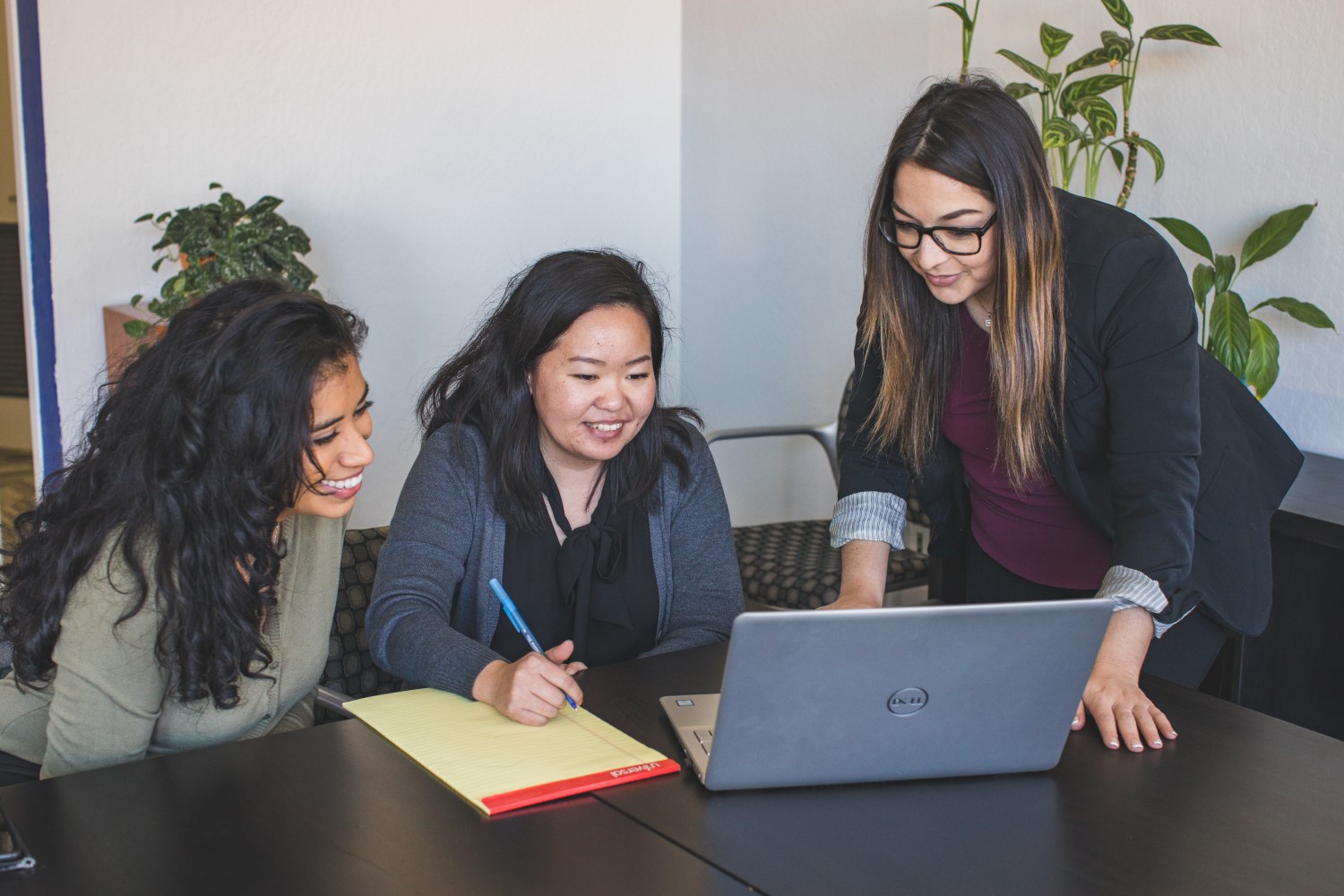
“It’s when you step out of your comfort zone that you begin to change, grow, and transform.” – Roy T. Bennett
It’s almost been two years since I’ve started at Valley Vision as a Project Associate, supporting the Healthy Communities portfolio and their first major statewide project. This project, Listos California, was initiated by Governor Newsom to prepare diverse and vulnerable Californians in emergency preparedness activities – including COVID-19.
I took a leap of faith to dive into the field of emergency preparedness that was beyond my initial career path. However, it was the core mission of the project to have a people-centered approach to help diverse populations that drew me in.
With our small but mighty team at Valley Vision, a strong team of consultants, hundreds of passionate community-based organizations and vendors across the state, and two visionary Listos California Co-Chairs with their own small but mighty team spearheading this effort, we surpassed the goal of preparing 1 million Californians for natural disasters and have, instead, reached 2.4 million Californians to education and engage on emergency preparedness for fire, earthquake, and more. We also overcame the pandemic by pivoting our strategies and adapting to the current turn of reality in the middle of it all.
As with each milestone comes reflections and lessons learned as it is essential to growth. Below are three key takeaways that I’ve gained to embrace change and hope this would be beneficial for those who are also on this journey of transformation at any point of their lives – while recognizing that this is easier said than done:
- Change is inevitable. The only thing that is predictable about change is that it will always be there (I know, the irony!). By accepting this, you release yourself from self-doubt.
- “Be formless, shapeless – like water.” – Bruce Lee. There are some events that are not controllable nor predictable and, quite frankly, sometimes flowing with the waves is easier than going against the currents.
- Give yourself compassion. You could be your own worst critic. If you’re learning something new, don’t beat yourself up for not perfecting it immediately. It takes time so please do forgive yourself.
As the project was wrapping up, I am pursuing an opportunity that fits my interests and next-step plans for career growth. My new position will give me the opportunity to work directly with small minority businesses to support their success.
Overall, I’m grateful for Valley Vision for the leap of faith in trusting me with the opportunity to support this work. If it weren’t for Valley Vision’s belief in me, I wouldn’t be poised for my next adventure. Valley Vision provided ample space to contribute my thoughts, be valued, learn from mistakes, and welcome any questions that I may have. I’d like to thank staff members who have been very supportive. To highlight a few, I’m thankful for Grace Kaufman and Kari MacDonald for being my cheerleaders on the field. I have Evan Schmidt’s words of encouragement readily in the forefront of my mind that I did the best I can today and can always do better the next day. Ultimately, there are no words that could express my deepest respect and appreciation for Alan Lange, deliberately managing the project with a calm and even-keeled hand that supported us all.
This is by no means goodbye to everyone I have engaged and connected with while at Valley Vision, but an ‘until next time’ or ‘see you later.’
The camaraderie developed during these past two years will never be forgotten and I know, going into my next experience, I will bring that camaraderie along with all that I’ve learned – launching into it more prepared and more resilient than ever.
Take care.
Houa Vang was a Project Associate supporting the Listos California project and Valley Vision’s Healthy Communities Impact Area.
Connecting Community and Data: COVID-19 Resilience Poll and Empower Yolo
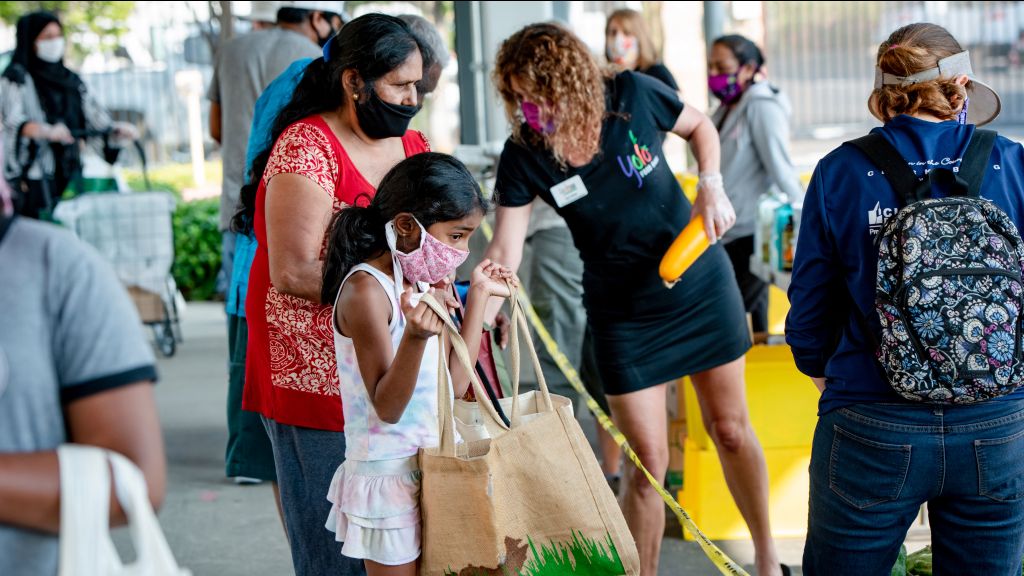
This piece was adapted from an article co-written by Evan Schmidt and Natalia Baltazar, Empower Yolo, published in the Davis Enterprise and the Empower Yolo website on March 6, 2021.
The pandemic has impacted every facet of life over the last year. With people increasingly at home and more isolated, domestic violence and substance use, as well as depression and anxiety are peaking in communities across the nation and our region.
To understand how COVID-19 has impacted our region over the last year, Valley Vision and Capital Public Radio in partnership with the Institute of Social Research at Sacramento State, have conducted The COVID-19 Resilience Poll. This is a public opinion poll that tracks experiences and perspectives on the impacts of COVID-19 in the Capital region, including Yolo, Sacramento, El Dorado, Placer, Yuba and Sutter counties, and is both demographically representative and statistically significant. The poll shows that physical safety at home and mental health effects of COVID-19 are significant and impact people of color, younger people, and women most significantly.
“In Yolo County Empower Yolo continues to support an influx of clients with increased domestic violence cases; clients needing help with basic necessities as well as emergency relief support to help pay rent, utilities and childcare. Over the past year, Empower Yolo’s restraining order clinic has been busier than ever. Many clients are struggling to provide basic needs for their families such as food, clothing and the ability to pay their rent and utilities. The need for childcare so that clients can go back to work is a real problem for working parents. We continue to work with community partners like the Yolo Food Bank to meet the huge rise in food distribution for vulnerable families, seniors, and the immigrant community,” says Lynnette Irlmeier, Executive Director, Empower Yolo.
Overall, a quarter of respondents (25%) from the poll are concerned about being physically or emotionally harmed by other members of their household. About a third of respondents are concerned about alcohol or substance abuse (34%) and the well being of children in the household (32%). As many as 63% of respondents reported feeling depressed at least once in the last seven days, and 82% of respondents reported feeling anxious at least once in the last seven days. These health impacts also continue to reflect different experiences in different communities.
Communities that were already on the margins and struggling due to systemic racism and oppression are hit the hardest due to increased daily stressors like a loss of job, homeschooling, or the inability to provide basic needs like food, clothing or paying rent.
“Most of the clients I work with every day are strong individuals,” says Josie Enriquez, Program Manager, Empower Yolo. “One of our clients was working in a restaurant and was laid off due to COVID. She spent all of her savings, but refused to get help because she is undocumented. Her brother has been helping her pay rent. She is also a survivor of domestic violence,” says Enriquez.
Some families have to rely on older children to help out with childcare when they have to work. “Low-income children are the ones suffering the most; many of the older children need to attend school, but they are also taking care of their siblings,” says, Enriquez.
Families that become sick need extra support to get back on their feet. “One of my clients had COVID and he had to quarantine. The entire family had COVID except for their 5-year-old daughter who was asymptomatic. His daughter was not able to participate in distance learning until we connected him with the local school district for support. He ended up staying home for about two months because the symptoms were severe. He had heart problems and anxiety on top of the regular COVID symptoms. Because he was home during this time to recover, he was able to support his daughter in virtual learning and she made progress. Empower Yolo also referred the family to STEAC, and is assisting the family in completing their tax return,” says Enriquez.
Women and younger respondents experienced more anxiety, depression, and hopelessness compared to other respondents. Eighty-nine percent of women and 93% of respondents aged 18-39 reported anxiety in the last seven days compared to 81% of overall respondents. Seventy-one percent of women and 82% of respondents aged 18-39 reported experiencing depression or hopelessness in the prior seven days compared to 65% of respondents overall.
Empower Yolo’s counseling department has been very busy throughout the pandemic trying to support clients’ various mental health needs. “Therapists are reporting seeing more clients than ever before; we are seeing a much higher rate of clients being depressed or anxious as a result of the pandemic,” says Amy Groven, Director of Clinical Programs, Empower Yolo. Depression and anxiety seem to impede many clients on things like getting a job so they can escape abuse. Because of quarantine clients are more isolated. “Clients are not reaching out to the support they do have as much, and many are experiencing feelings of being helpless or very lonely as they go through the pandemic trying to navigate a new life for themselves,” says Groven.
Respondents’ answers to open-ended questions further demonstrate the ways in which the COVID-19 pandemic is taking its toll. When asked how it is impacting them the most, 49% of respondents felt it most acutely in their routines, including a loss of social connection with community or church, followed by travel cancellations, loss of entertainment, and loss of normal services.
“We have seen younger people coming in with depression and anxiety, which is nothing new. Most of our clients have those diagnoses because of what they have endured. The pandemic has only compounded these issues, making it difficult for youths to socialize and build self esteem because there aren’t those normal things to do that are regularly built into their lives (like school, sports, scouts, etc.) that they gain mastery through. Now we are seeing youths who have endured trauma and have lost those things to cling to that inspire hope and resiliency,” says Groven.
Empower Yolo provides comprehensive services to survivors of domestic violence, sexual assault, human trafficking and child abuse. Core services include a 24-hour crisis line, emergency shelter, legal advocacy, and counseling. Legal services include restraining order clinics throughout Yolo County, family legal clinic, and child support appointments. The emergency safe house continues to support survivors of abuse and their families and pets including running two virtual classrooms for the children residing at the shelter. Throughout the pandemic shelter staff have worked through the challenges of keeping clients and their families safe and healthy while living in a communal living situation. The work of Empower Yolo, and other social services across the region, is critical to meet community needs during this difficult time.
Valley Vision is proud to partner with Empower Yolo to shed light on the challenges and the resilience in our communities and tell the stories behind the number of the COVID-19 Resilience Poll. You can support Empower Yolo and learn more about their services here. Working together, we can rebuild our community to be safer, healthier and more resilient.
Last year, Valley Vision partnered with Capital Public Radio and Sacramento State’s Institute for Social Research to launch the COVID-19 Resilience Poll series consisting of three Polls. These polls are helping us understand and navigate the challenges ahead as we aim to not just understand the impacts and recover from the setbacks of COVID-19, but also reimagine a more equitable, sustainable, and just future.
To keep up with Valley Vision’s work to advance livability in the Sacramento region, subscribe to our Vantage Point email newsletter!
Evan Schmidt is Valley Vision’s Chief Executive Officer.
Improving Air Quality in North Sacramento and Oak Park
Across the Sacramento region, community leaders and organizations are collaborating to achieve Environmental Justice, defined by local advocates as “the basic right of people to live, work, go to school, play, and pray in a safe, healthy, and clean environment.” Valley Vision is excited to be part of these efforts as we advance a new project to improve air quality in two frontline communities in Sacramento County.
Much of this momentum can be attributed to recent action at the State level. In 2017, Assembly Bill 617 was signed into law, which created the Community Air Protection Program run by the California Air Resources Board (CARB). The Community Air Protection Program empowers California’s most polluted communities to monitor their air quality and guide investments to reduce harmful emissions and improve public health in frontline neighborhoods. Valley Vision has been active in AB 617 advocacy since the legislation was signed by Governor Brown in 2017, including a strong effort in early 2018 to ensure Sacramento’s inclusion in the program, but more recently our work took on a new and critical purpose.
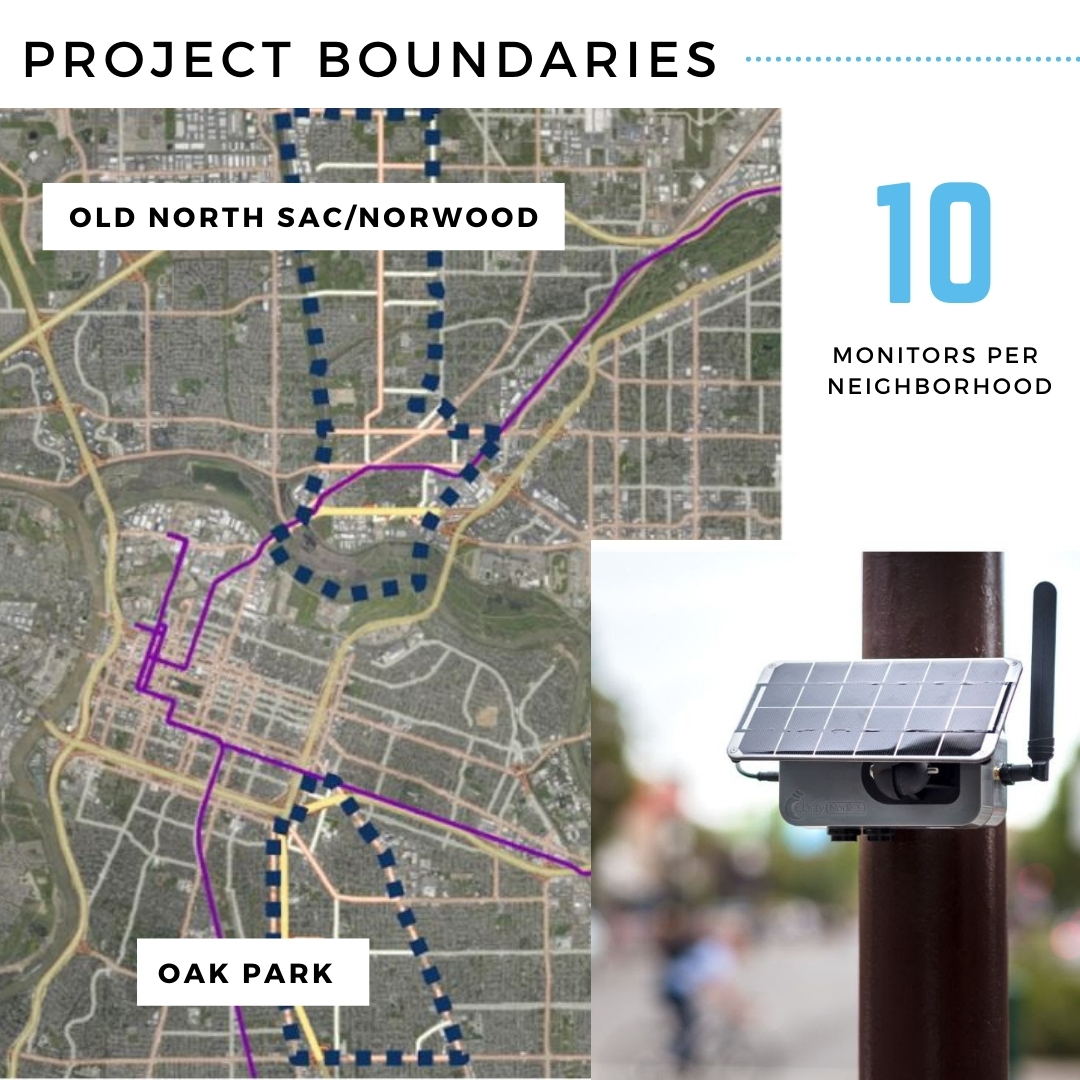
The work is focused on North Sacramento and Oak Park.
Last year, CARB awarded a two-year Community Air Grant to a group of local nonprofit organizations – Valley Vision, WALKSacramento, Breathe CA Sacramento Region, and Green Tech Education – to help the North Sacramento/Norwood and Oak Park neighborhoods monitor their air, understand how air quality impacts health, and develop a plan to reduce exposure to air pollution. Both of these communities are formerly redlined and underinvested air monitoring “deserts” with little available pollution data, and both have been nominated by the Sac Metro Air District for formal consideration by CARB as priority communities for pollution reduction programs.
The purpose of AB 617 is to empower communities to identify their own solutions in achieving better air quality, and our project centers on supplying the tools and resources for residents to do just that. To this end, our work is guided by a Project Advisory Committee (PAC) of 13 community members and technical experts. A majority of PAC members are eligible to be paid for their participation – a best practice for those seeking meaningful community engagement. You can learn more about the PAC on the project web page.
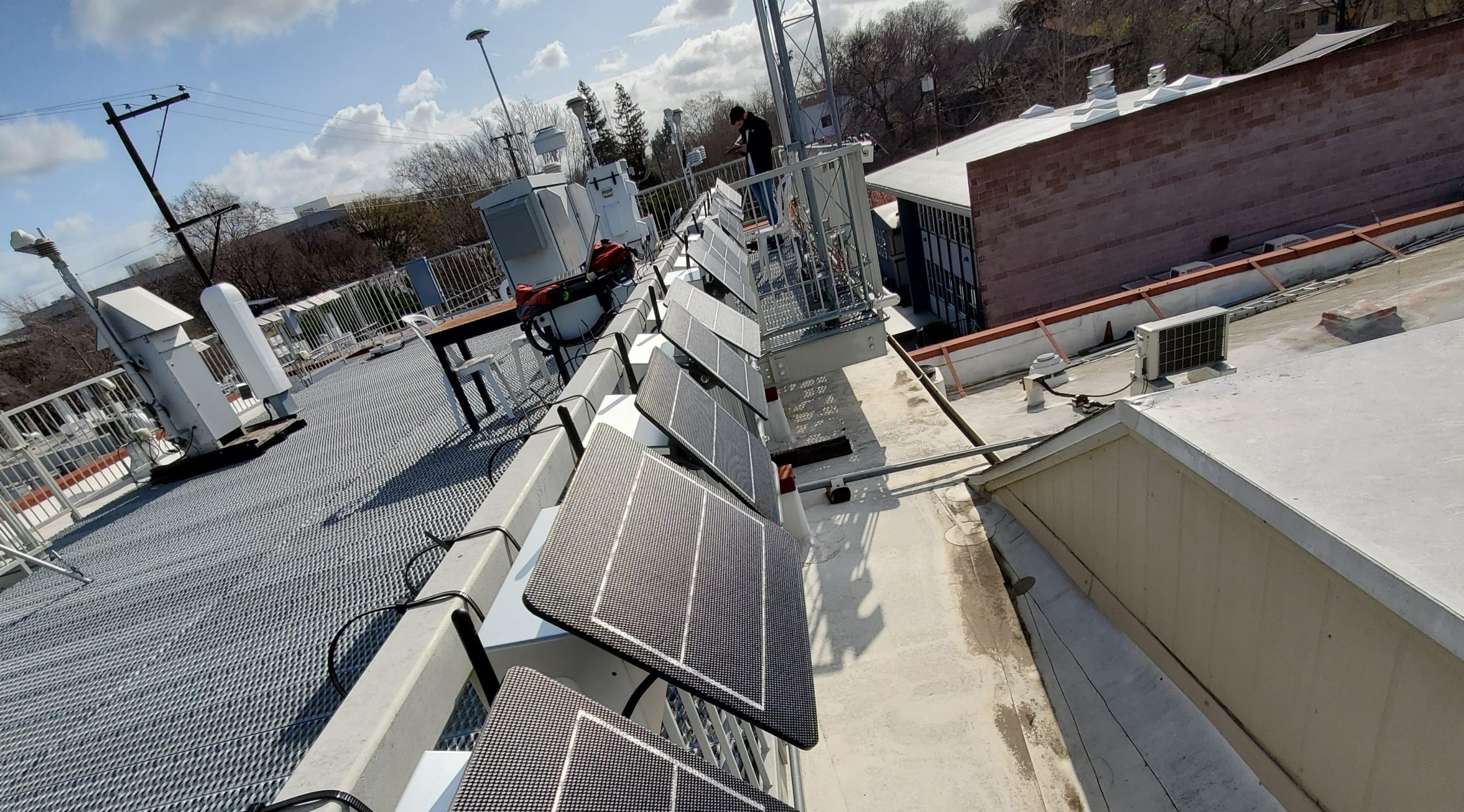
Our next major milestone is placing 20 Clarity Node-S air monitors (10 in each neighborhood) in locations determined by residents, and creating a public data portal where people can access real-time emissions information. Led by WALKSacramento, the team has already hosted four public listening sessions to seek community input, with live translation offered in Spanish, Vietnamese, and Hmong, and put out a multilingual survey to gather information from residents about priority locations for the air monitors to be placed. We are currently working with our PAC to review the dozens of applications that came in from both neighborhoods to determine which residents are eligible and interested in making these important siting decisions. Of course, residents who participate are being offered stipends of $75 per meeting attended.
The work of Sacramento Neighborhoods Activating on Air Quality will last through March 2022, with the following milestones:

As you can see, we’ve got our work cut out for us. Once the two air monitoring networks are deployed in locations determined by residents, we are funded to continue working with community members on an educational curriculum to ensure shared understanding of air quality and its effects on public health, further community workshops and planning efforts to identify community-led solutions, a Hackathon to begin to develop technological tools, and finally a Community Air Action Plan which can be elevated to the CA Air Resources Board to secure resources and to enforce new rules in line with community priorities.
Overall, we believe that the resources and tools that we are bringing to the table will help residents move the needle on public health in our region’s frontline neighborhoods. Especially in the age of COVID-19, it is absolutely critical that we address environmental and health disparities by empowering communities with real decision-making power, and do it in a transparent and equitable manner.
If you have any feedback to share or are interested in partnering in this work, please reach out by emailing adrian.rehn@valleyvision.org! To stay up to date with our work to improve regional air quality, subscribe to Valley Vision’s “Cleaner Air News” email newsletter!
Adrian Rehn is a Valley Vision Project Leader overseeing the Cleaner Air Partnership, Sacramento Neighborhoods Activating on Air Quality, and Valley Vision’s online communications.